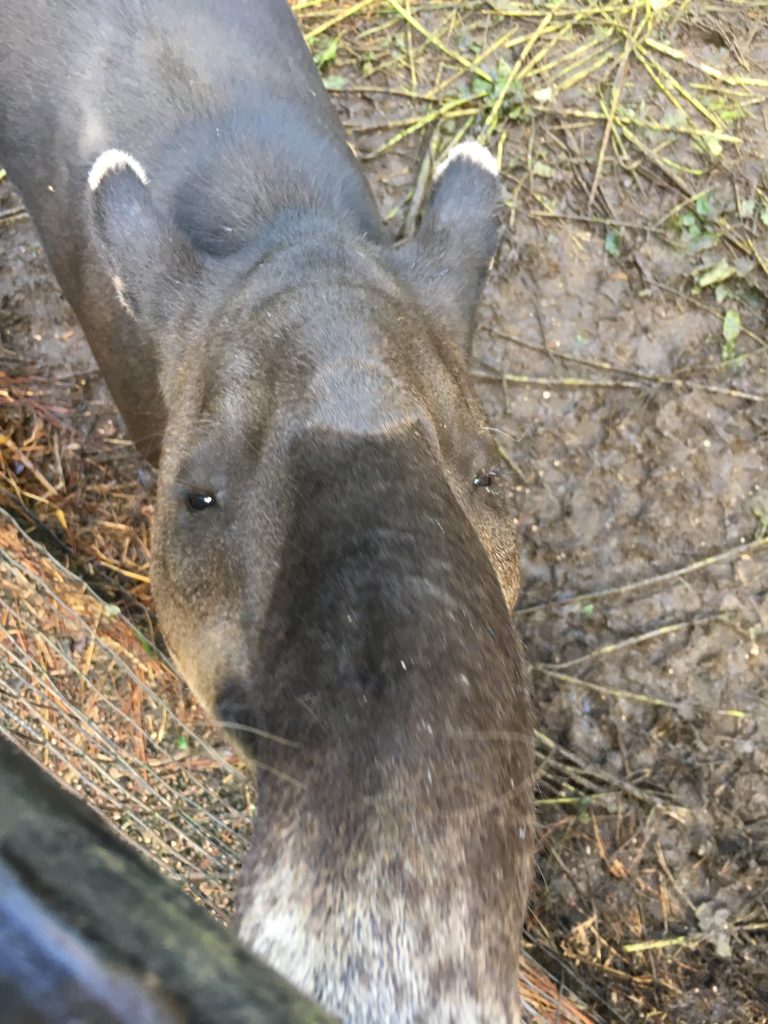
Sarah listens to a jaguar’s heart at the Belize Zoo.
Hello! My name is Sarah and I’m currently a second year vet student. This winter break I spent a week in Belize. While Belize is a wonderful destination for visiting the beach, I wasn’t there for vacation: I was there for a Cornell class called “Field Techniques in International Wildlife Medicine.” Needless to say, as an aspiring wildlife veterinarian, this course was without a doubt the most fun, challenging and rewarding course that I’ve taken at Cornell so far!
The course is a collaboration between Cornell College of Veterinary Medicine and the Belize Zoo. The Belize Zoo was founded by Sharon Matola in 1982, and is so much more than a zoo. In my mind, the zoo is more like a sanctuary, rescuing and showcasing the native fauna and flora of Belize to educate locals and tourists alike. In fact, every species at the zoo is native to Belize. The exhibits for the animals are spacious and lush with native plants. It looks like these animals are living in protected plots of land in their native savannah, because they essentially are. Additionally, the zoo’s wild animals are all rescued. Some of the animals are orphans; others were kept as pets for some time before being surrendered to the zoo. The zoo is also a home for “problem jaguars” – jaguars who, for whatever reason, developed a taste for domestic animals. Unfortunately, once a jaguar develops a taste for easy targets like sheep on a farm, much to the farmer’s dismay, the jaguar does not go back to hunting its regular prey species like peccaries. So, as retaliation, some Belizean farmers may attempt to kill jaguars who are eating their source of income. In order to solve this problem, the zoo helps rescue these jaguars and gives them sanctuary.

A tapir says hello!
The Belize Zoo’s purpose is as much about education as it is about the welfare of these animals. Many of the people of Belize didn’t know about the amazing wildlife in their own backyards until the zoo began educating them. It is also helping to dispel some myths engrained in the Belizean culture that will ultimately help preserve endangered species populations, such as the fallacy that tapirs can skin a human alive with their snouts. I found this myth especially ironic because the tapirs at the zoo are so friendly! I got to hand feed a tapir a carrot and clearly left the encounter unscathed. This proves the value of education in promoting any conservation mission.
The course at the zoo is a win-win: our amazing faculty lead the effort to address any medical problems or routine examinations the animals may need, the keepers and staff at the zoo learn new animal management and medical techniques from the professors, the health of the animals is improved, and the veterinary students get the unparalleled learning experience of assisting with everything from routine vaccinations of the zoo’s collection of animals to complex surgeries. In one week, I got to test a howler monkey for tuberculosis, diagnose external parasites on a kinkajou via skin scraping, and assist with a root canal on a jaguar, among many other incredible opportunities. This trip certainly reaffirmed my passion for clinical zoological medicine and desire to work to conserve the endangered species of animals in Belize and around the world.
The history of the Belize Zoo, as well as the conservation efforts that have been undertaken to preserve the biodiversity of Belize, are probably of great interest to any budding conservationist. If you’re looking to learn more, I highly recommend that you read “The Last Flight of the Scarlet Macaw” by Bruce Barcott, a book about Sharon Matola’s efforts to save the scarlet macaw populations in Belize. I would like to thank all of the Cornell faculty who led the trip and taught me so much over the course of merely a week, the lovely staff at the Belize Zoo and Tropical Education Center who hosted us so generously, and my fellow classmates who made the trip full of some of my favorite vet school memories.
ABOUT THE AUTHOR: Sarah Balik is a second-year DVM student at Cornell Univeristy College of Veterinary Medicine. She is also dual-enrolled in the Master of Public Health program through the University of Minnesota. Sarah is an aspiring wildlife veterinarian who hopes to help save endangered species by working at the interface of conservation and human public health.



